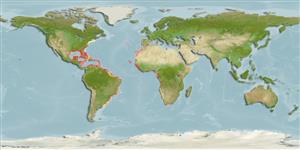Actinopterygii (ray-finned fishes) >
Tetraodontiformes (Puffers and filefishes) >
Ostraciidae (Boxfishes)
Etymology: Acanthostracion: Greek, akantha = thorn + Greek, ostrakon = shell (Ref. 45335).
Environment / Climate / Range
Ecology
Marine; reef-associated; depth range 1 - 80 m (Ref. 26938), usually 10 - 30 m (Ref. 40849). Subtropical, preferred ?; 43°N - 37°S, 98°W - 26°E
Atlantic Ocean: in tropical and temperate waters (Ref. 3696). Western Atlantic: Massachusetts (USA), Bermuda, and northern Gulf of Mexico to southeastern Brazil. Reported from tip of South Africa.
Length at first maturity / Size / Weight / Age
Maturity: Lm 22.2, range 17 - ? cm
Max length : 55.0 cm TL male/unsexed; (Ref. 6937); common length : 20.0 cm TL male/unsexed; (Ref. 3696)
Dorsal
spines
(total): 0;
Dorsal
soft rays
(total): 10;
Anal
spines: 0;
Anal
soft rays: 10. Dark markings on head and body; parallel bands on cheek. Pair of prominent spines projecting from in front of eyes suggests cow horns. Second pair of spines at lower rear corners of cuirass (Ref. 26938). Body deep, covered with hexagonal dermal plates (Ref. 37521).
Found in shallow water down to about 80 m, mainly in seagrass beds (Ref. 3696). Feeds on sessile invertebrates such as tunicates, gorgonians and anemones, as well as on slow-moving crustaceans, sponges (Ref. 3696), hermit crabs and marine plants (Ref. 13442). Oviparous (Ref. 205). Considered an excellent food fish; marketed fresh (Ref. 3696).
Smith, M.M., 1986. Ostraciidae. p. 890-893. In M.M. Smith and P.C. Heemstra (eds.) Smiths' sea fishes. Springer-Verlag, Berlin. (Ref. 3141)
IUCN Red List Status (Ref. 115185)
CITES (Ref. 94142)
Not Evaluated
Threat to humans
Reports of ciguatera poisoning (Ref. 30303)
Human uses
Fisheries: minor commercial; aquarium: commercial
More information
ReferencesAquacultureAquaculture profileStrainsGeneticsAllele frequenciesHeritabilityDiseasesProcessingMass conversion
Tools
Special reports
Download XML
Internet sources
